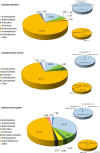Endorhizosphere of indigenous succulent halophytes: a valuable resource of plant growth promoting bacteria
- PMID: 36934265
- PMCID: PMC10024849
- DOI: 10.1186/s40793-023-00477-x
Endorhizosphere of indigenous succulent halophytes: a valuable resource of plant growth promoting bacteria
Abstract
The adaptability of halophytes to increased soil salinity is related to complex rhizosphere interactions. In this study, an integrative approach, combining culture-independent and culture-dependent techniques was used to analyze the bacterial communities in the endorizosphere of indigenous succulent halophytes Salicornia europaea, Suaeda maritima, and Camphorosma annua from the natural salt marshes of Slano Kopovo (Serbia). The 16 S rDNA analyses gave, for the first time, an insight into the composition of the endophytic bacterial communities of S. maritima and C. annua. We have found that the composition of endophyte microbiomes in the same habitat is to some extent influenced by plant species. A cultivable portion of the halophyte microbiota was tested at different NaCl concentrations for the set of plant growth promoting (PGP) traits. Through the mining of indigenous halotolerant endophytes, we obtained a collection representing a core endophyte microbiome conferring desirable PGP traits. The majority (65%) of the selected strains belonged to the common halotolerant/halophilic genera Halomonas, Kushneria, and Halobacillus, with representatives exhibiting multiple PGP traits, and retaining beneficial traits in conditions of the increased salinity. The results suggest that the root endosphere of halophytes is a valuable source of PGP bacteria supporting plant growth and fitness in salt-affected soils.
Keywords: Endophytes; Halotolerance; Microbiota; PGP traits; Succulent halophytes.
© 2023. The Author(s).
Conflict of interest statement
The authors declare that they have no competing interests.
Figures



Similar articles
-
Bacterial Diversity Associated With the Rhizosphere and Endosphere of Two Halophytes: Glaux maritima and Salicornia europaea.Front Microbiol. 2018 Nov 28;9:2878. doi: 10.3389/fmicb.2018.02878. eCollection 2018. Front Microbiol. 2018. PMID: 30555434 Free PMC article.
-
Characterization of halotolerant Kushneria isolates that stimulate growth of alfalfa in saline conditions.PLoS One. 2025 May 7;20(5):e0322979. doi: 10.1371/journal.pone.0322979. eCollection 2025. PLoS One. 2025. PMID: 40333926 Free PMC article.
-
Diversity of Bacterial Microbiota of Coastal Halophyte Limonium sinense and Amelioration of Salinity Stress Damage by Symbiotic Plant Growth-Promoting Actinobacterium Glutamicibacter halophytocola KLBMP 5180.Appl Environ Microbiol. 2018 Sep 17;84(19):e01533-18. doi: 10.1128/AEM.01533-18. Print 2018 Oct 1. Appl Environ Microbiol. 2018. PMID: 30054358 Free PMC article.
-
Halophilic Plant-Associated Bacteria with Plant-Growth-Promoting Potential.Microorganisms. 2023 Dec 2;11(12):2910. doi: 10.3390/microorganisms11122910. Microorganisms. 2023. PMID: 38138054 Free PMC article. Review.
-
Mining Halophytes for Plant Growth-Promoting Halotolerant Bacteria to Enhance the Salinity Tolerance of Non-halophytic Crops.Front Microbiol. 2018 Feb 8;9:148. doi: 10.3389/fmicb.2018.00148. eCollection 2018. Front Microbiol. 2018. PMID: 29472908 Free PMC article. Review.
Cited by
-
Thermal sensitivity and niche plasticity of generalist and specialist leaf-endophytic bacteria in Mangrove Kandelia obovata.Commun Biol. 2025 Jan 3;8(1):5. doi: 10.1038/s42003-024-07446-1. Commun Biol. 2025. PMID: 39753754 Free PMC article.
-
Plant-associated halotolerant bacteria improving growth of Vicia faba L. Mariout-2 under salinity conditions.Sci Rep. 2024 Jul 20;14(1):16737. doi: 10.1038/s41598-024-66504-0. Sci Rep. 2024. PMID: 39033227 Free PMC article.
-
Dynamic interaction of antibiotic resistance between plant microbiome and organic fertilizers: sources, dissemination, and health risks.World J Microbiol Biotechnol. 2024 Dec 18;41(1):4. doi: 10.1007/s11274-024-04214-5. World J Microbiol Biotechnol. 2024. PMID: 39690351 Review.
References
-
- Abbas H, Patel RM, Parekh VB. Culturable endophytic bacteria from halotolerant Salicornia brachata L.: isolation and plant growth promoting traits. IJAM. 2018;21:10–21. doi: 10.46798/ijam.2018.v21i01.002. - DOI
-
- Aslam F, Ali B. Halotolerant Bacterial Diversity Associated with Suaeda fruticosa (L.) Forssk. Improved growth of maize under salinity stress. Agronomy. 2018;8:131. doi: 10.3390/agronomy8080131. - DOI
Grants and funding
- 451-03-47/2023-01/ 200042/Ministarstvo Prosvete, Nauke i Tehnološkog Razvoja
- 451-03-47/2023-01/ 200042/Ministarstvo Prosvete, Nauke i Tehnološkog Razvoja
- 451-03-47/2023-01/200116/Ministarstvo Prosvete, Nauke i Tehnološkog Razvoja
- 451-03-47/2023-01/200116/Ministarstvo Prosvete, Nauke i Tehnološkog Razvoja
LinkOut - more resources
Full Text Sources
Miscellaneous
